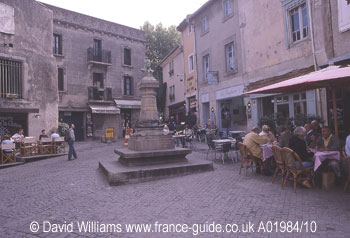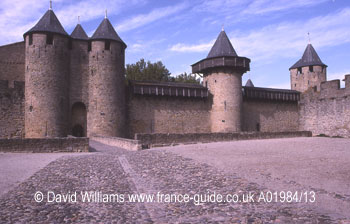 |
| This little square has a monument to Jean Pierre Cros-Mayrevieille. |
 |
| This is Château Comtal and its main entrance is the small opening between the two towers on the left. |
Beyond the square stood the entrance to the Château Comtal, originally the Trencavels` palace. Louis IX made various modifications to it and added a large semi-circular barbican and the wide moat. The château now houses an archaeological museum with exhibits from the Cité and the local region.
A broad road
ran downhill to the left, past a little park which gave excellent views
of the château. Then more souvenir shops, less tackier than those
seen earlier. Rue St Louis wound its way to a handsome square, at whose
far end was the Basilique Saint-Nazaire et Saint-Celse (the former cathedral),
which dates back to around the tenth century. This is an austere structure
with two tall rectangular towers; the church`s most intriguing features
were the large and hideous gargoyles which gave an air of levity to this
serious bit of ecclesiastical architecture. A young rucksack-carrying
priest and a group of tourists waited patiently in the shade of the walls
for the church`s side door to open.
To the right of the church stood the Hôtel de la Cité, its
ivy-covered walls making it look more "pretty" than "grand".
It was built in 1909 and is on the site of the former Bishop`s Palace.
A souvenir shop stood opposite the hotel and its main attempt to offer
something new to tourists was a machine which encouraged the visitor (in
English) to "Press your own penny into a souvenir design". One
young boy decided to try his hand at this metalworking machine by putting
in a 1 euro coin and a 5 cent coin. He then slowly and determinedly turned
a large handle; this operated the die which squashed and stretched his
5 cent coin into an oval medallion which now bore a relief picture depicting
the outline of the citadel. The lad seemed contented with his handiwork
but I was sure that the European bankers would take a dim view of this
desecration of their currency.
| Next Page |
| First page of this article |